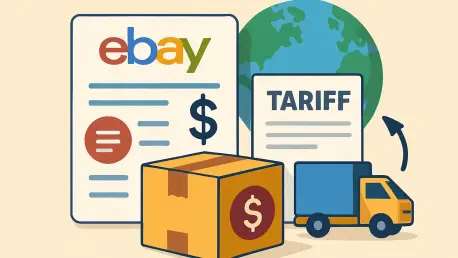In a startling revelation that has left online shoppers reeling, a recent incident involving an eBay seller listing a simple kitchen tool for $20.99 with an astronomical $10,000 shipping fee has exposed critical vulnerabilities in the e-commerce landscape. This eye-opening case, brought to attention by Paul Michel, a resident of Redwood City, California, underscores the hidden dangers lurking in online marketplaces. While searching for a kitchen appliance part, Michel narrowly escaped a financial disaster upon discovering the exorbitant shipping cost tucked away in fine print. The seller, an Italy-based entity known as PG Service, attributed this inflated fee to new U.S. import tariffs and complications with customs authorities. Far from an isolated anomaly, this situation points to broader systemic issues, from transparency in pricing to the ripple effects of international trade policies, raising urgent questions about consumer protection on platforms like eBay. As global trade complexities intertwine with digital shopping, the risks for unsuspecting buyers are becoming increasingly evident.
The Impact of Tariffs on Online Shopping
Trade Policies Disrupting E-Commerce Dynamics
The heart of this troubling incident lies in the disruptive influence of U.S. import tariffs on the online shopping ecosystem. PG Service, the seller behind the staggering $10,000 shipping fee, explained that this charge was a symbolic gesture reflecting the barriers imposed by tariffs and the challenges of navigating U.S. customs protocols. Such trade policies, designed to regulate international commerce, often create unintended consequences for small-scale transactions on platforms like eBay. Sellers, caught between compliance with these regulations and the limitations of marketplace settings, may resort to extreme pricing tactics to signal their inability to ship to certain regions. This leaves consumers facing unexpected costs that can transform a modest purchase into a financial burden. The incident with Michel serves as a stark reminder that global trade rules are not just abstract policies but tangible factors that can directly impact the affordability and accessibility of goods in the digital marketplace.
Seller Constraints and Marketplace Limitations
Beyond the direct effects of tariffs, the constraints faced by international sellers on eBay reveal a deeper structural issue within the platform’s framework. PG Service highlighted their inability to exclude the U.S. from their shipping options, a restriction imposed by eBay’s policies that forced them to list the item with an inflated fee as a workaround. This limitation illustrates a disconnect between the operational needs of sellers navigating trade barriers and the tools provided by online marketplaces to manage such challenges. For buyers like Michel, this translates into potential traps where a low product price masks a prohibitive shipping cost, buried in the checkout process. The broader implication is that without flexible options for sellers to adapt to regional trade restrictions, consumers are left vulnerable to misleading pricing practices. This case underscores the need for eBay to revisit its policies to better align with the realities of international commerce in an era of heightened tariff scrutiny.
Consumer Protection and Platform Accountability
Disparities in Regional Platform Features
A significant concern emerging from Michel’s experience is the glaring inconsistency in how eBay handles shipping transparency across its regional platforms. On the Canadian version of the site, users are met with prominent red notices alerting them to shipping restrictions, effectively preventing costly mistakes before they occur. In stark contrast, the U.S. platform lacks such clear warnings, allowing items with exorbitant fees to slip into shopping carts with critical cost details hidden in small print. This discrepancy raises serious questions about why protective measures, already implemented in some regions, are not standardized globally. For American shoppers, this gap in transparency heightens the risk of financial missteps, especially when dealing with international listings. Michel’s near-miss with a $10,000 fee highlights how such oversight failures can erode trust in a platform that millions rely on for safe and straightforward transactions.
Delays and Inaction in Addressing Complaints
Equally troubling is the apparent sluggishness of eBay’s response to consumer grievances, as evidenced by Michel’s futile attempts to seek resolution. After flagging the problematic listing, he encountered a frustrating cycle of automated replies and unfulfilled promises of follow-up from customer service. Even two months after his initial complaint, no visible changes were made to the listing or broader platform policies to prevent similar issues. This reactive stance, rather than a proactive effort to safeguard users, suggests a gap in prioritizing consumer safety over operational convenience. Michel’s sentiment that the platform isn’t doing enough to protect its users resonates as a broader critique of eBay’s accountability. When buyers face delays and inaction, confidence in the marketplace diminishes, leaving them to navigate potential pitfalls without adequate support. This incident calls for a reevaluation of how swiftly and effectively online platforms address user concerns in real time.
Risks for Online Shoppers in a Global Market
Perils of Overlooked Fees in Hasty Purchases
One of the most pressing dangers illuminated by this incident is the ease with which online shoppers can fall victim to hidden fees during rushed transactions. In an era where speed often trumps caution, many buyers may overlook critical details like a $10,000 shipping charge attached to a seemingly affordable $20.99 item. The risk is particularly acute on platforms hosting international sellers, where unconventional pricing strategies might be employed to circumvent shipping barriers. Michel’s close call serves as a cautionary tale for countless others who might not scrutinize the fine print before finalizing a purchase. This vulnerability is compounded by the fast-paced nature of e-commerce, where a single click can lock in a devastating financial commitment. As online shopping continues to dominate consumer behavior, awareness of such pitfalls becomes essential to avoid turning a bargain hunt into an expensive lesson.
Navigating Uncertainties in International Deals
The complexities of cross-border transactions add another layer of uncertainty for online shoppers, as Michel’s rhetorical concern about refunds from distant sellers poignantly illustrates. With tariffs and customs regulations creating an unpredictable pricing landscape, buyers engaging with international listings on eBay face heightened risks of miscommunication and financial loss. The lack of clarity around whether a purchase from a far-flung location would result in a refund if issues arise only deepens this unease. Michel’s experience with PG Service reveals how global trade policies can obscure the reliability of transactions, leaving consumers to second-guess every deal. This uncertainty underscores the importance of meticulous attention to detail when shopping across borders. Until platforms can offer stronger guarantees or clearer guidelines for international purchases, buyers must remain vigilant to protect themselves from the hidden hazards of a global marketplace.
Looking Ahead: Safeguarding the Future of E-Commerce
Reflecting on the unsettling experience of Paul Michel with a deceptive $10,000 shipping fee, it becomes clear that the intersection of tariffs and online shopping has created unforeseen challenges for both sellers and buyers. The disparities between regional platforms and the slow response to user complaints have exposed significant gaps in consumer protection on eBay’s U.S. site. Moving forward, actionable steps must be prioritized to prevent such incidents from recurring. eBay should consider standardizing transparent warnings about shipping restrictions across all regions, ensuring that no buyer is blindsided by hidden costs. Additionally, enhancing seller tools to better manage trade barriers could reduce the reliance on misleading pricing tactics. For consumers, adopting a habit of thoroughly reviewing purchase totals before checkout emerges as a critical defense against potential traps. As the e-commerce landscape evolves with shifting trade policies, platforms and shoppers alike must adapt to foster a safer, more trustworthy digital marketplace.









